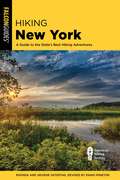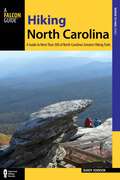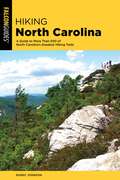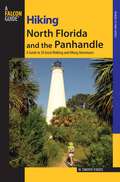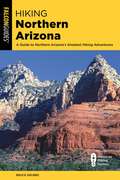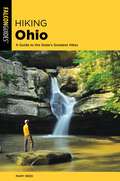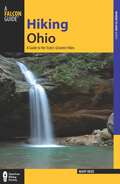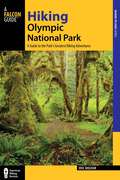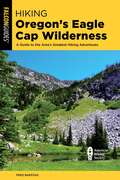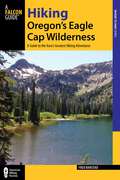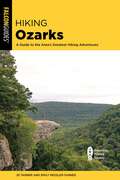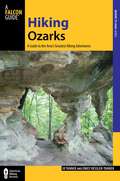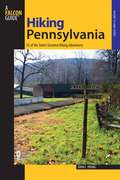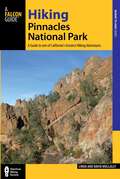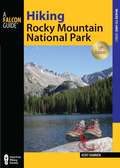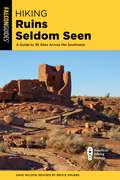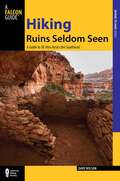- Table View
- List View
Hiking New York: A Guide to the State's Best Hiking Adventures
by Randi MinetorThis updated guidebook features seventy-five of the best trails the Empire State has to offer—from the 4,000-foot peaks of the Adirondacks and the lore of Rip Van Winkle&’s Catskills, to the glacier-gouged landscape of the Finger Lakes region.Each featured hike includes detailed hike specs and descriptions, trailhead location and GPS coordinates, mile-by-mile directional cues, gorgeous full-color photography, and a detailed map.
Hiking North Carolina: A Guide to More Than 500 of North Carolina's Greatest Hiking Trails (State Hiking Guides Series)
by Randy JohnsonFrom the Great Smokies and the Blue Ridge Parkway to the Piedmont and the Outer Banks, this thoroughly updated and revised guide features more than 200 hiking trails in all regions of the state.
Hiking North Carolina: A Guide to More Than 500 of North Carolina's Greatest Hiking Trails (State Hiking Guides Series)
by Randy JohnsonIn March 2021, Hiking North Carolina, 4th edition received a bronze award in the "best travel book or guide" category from the North American Travel Journalists Association competition.With full color photographs and maps, this thoroughly updated and revised fourth edition is a guide to more than 500 hiking trails in all regions of the state, from the Great Smokies and the Blue Ridge Parkway to the Piedmont and the Outer Banks.
Hiking North Florida and the Panhandle: A Guide to 30 Great Walking and Hiking Adventures (Regional Hiking Series)
by M. Timothy O'KeefeHiking North Florida and the Panhandle describes 30 hikes designed to highlight some of the best natural areas throughout the region. The hikes in this book fall into four different categories: Short Family Walks ranging from 1-3 miles, Day Hikes from 3-12 miles, Overnight Hikes with easy walks to primitive campsites and Long Haulers, true backpacking experiences that require a weekend to complete.
Hiking Northern Arizona: A Guide To Northern Arizona's Greatest Hiking Adventures (State Hiking Guides Series)
by Bruce GrubbsThis guide has completely updated information for 120 hikes in northern Arizona, including the Grand Canyon, with different routes suggested for each season. From short strolls to overnight desert adventures, this book contains new, easy-to-read maps, beautiful black and white photos, up-to-date trail information, routes for beginners and experts, anecdotal narratives, and wildlife descriptions along popular trails as well as those less traveled.
Hiking Northern California: A Guide to the Region's Greatest Hiking Adventures (Regional Hiking Series)
by Bubba SuessHiking Northern California, the revised edition, will be fully revised and updated. Northern California has 80-plus diverse hikes throughout the northern two-thirds of the Golden State, from the Oregon border to the Southern Sierras. This guidebook features more than 600 miles of trails, accurate and up-to-date trail maps, and all the information you need for planning enjoyable outings year-round. Hikes include short, leisurely strolls and demanding days-long excursions, from well-graded trails to rugged, cross-country scrambles.
Hiking Ohio: A Guide To The State's Greatest Hikes (State Hiking Guides Series)
by Mary ReedHiking Ohio is a comprehensive guide to more than forty of the most scenic foot trails in the Buckeye State. Hike along beaches, over boardwalks, through gorges, past waterfalls, into caves, near wildlife, under forest canopies, and through carpets of wildflowers. Trek along secluded footpaths through Ohio's virgin forest and keep your eyes peeled for white-tailed deer, wild turkey, ruffed grouse, beaver, fox, and, in the eastern part of the state, black bear. Whether you are a day-tripper looking for a short day hike or longer-distance hiker yearning for an extended backpacking trip, this guidebook has plenty to offer and is an excellent way to see all the state has to offer.
Hiking Ohio: A Guide to the State's Greatest Hikes (State Hiking Guides Series)
by Mary ReedMany with full-color maps and photos! Each book includes:Up-to-date trail descriptions with mile-by-mile directional cuesDetailed trail maps and GPS coordinatesDifficulty ratings and average hiking timesA Trail Finder for best hikes with dogs, with children, for great views, or for wildlife viewingInformation on fees and permits, contacts, attractions, restaurants, accommodations, and canine compatibilityLeave No Trace and wilderness safety tips and techniques
Hiking Ohio: A Guide to the State's Greatest Hiking Adventures
by Mary ReedHiking Ohio is a comprehensive guide to more than forty of the most scenic foot trails in the Buckeye State. Hike along beaches, over boardwalks, through gorges, past waterfalls, into caves, near wildlife, under forest canopies, and through carpets of wildflowers. Trek along secluded footpaths through Ohio's virgin forest and keep your eyes peeled for white-tailed deer, wild turkey, ruffed grouse, beaver, fox, and, in the eastern part of the state, black bear. Whether you are a day-tripper looking for a short day hike or longer-distance hiker yearning for an extended backpacking trip, this guidebook has plenty to offer and is an excellent way to see all the state has to offer.
Hiking Oklahoma: A Guide to the State's Greatest Hiking Adventures (State Hiking Guides Series)
by Jamie FleckThis visual trail guide allows readers and hikers to explore all the natural grandeur that Oklahoma has to offer. Captivating photography, vital hike specs, trailhead gps coordinates, turn-by-turn directions and informative maps guide readers to 48 of Oklahoma&’s most scenic day hikes. As a long-awaited and much-needed resource, Hiking Oklahoma covers some of the most picturesque and rewarding trails in the state. Hikes cover the entire state: Red Carpet Country (northwest Oklahoma), Great Plains Country (southwest Oklahoma) Frontier Country (central Oklahoma), Chickasaw Country (south central Oklahoma), Green Country (northeast Oklahoma), and Choctaw Country (southeast Oklahoma).
Hiking Olympic National Park: A Guide to the Park's Greatest Hiking Adventures (Regional Hiking Series)
by Erik MolvarThis updated edition of Hiking Olympic National Park features 66 of the finest trails in and around the park plus 40 additional trail recommendations throughout northwest Washington&’s spectacular landscape. These trails crisscross the park&’s wilderness ecosystem, stretching from the beaches of the Pacific to the heart of the Olympic Mountains. Whether you choose a strenuous backpacking trip over glacier-clad mountains or a short stroll through a temperate rain forest, veteran trail guide and author Erik Molvar provides all the information you need to make the most of hiking the Olympic Peninsula.Look inside to find:Hikes suited to every abilityFull-color photosGPS coordinatesDirections to the trailheadMile-by-mile directional cues
Hiking Olympic National Park: A Guide to the Park's Greatest Hiking Adventures (Regional Hiking Series)
by Erik MolvarThis fourth edition of Hiking Olympic National Park features 66 of the finest trails in and around the park plus 40 additional trail recommendations throughout northwest Washington&’s spectacular landscape. These trails crisscross the park&’s wilderness ecosystem, stretching from the beaches of the Pacific to the heart of the Olympic Mountains. Whether you choose a strenuous backpacking trip over glacier-clad mountains or a short stroll through a temperate rain forest, veteran trail guide and author Erik Molvar provides all the information you need to make the most of hiking the Olympic Peninsula.Look inside to find:Hikes suited to every abilityFull-color photosGPS coordinatesDirections to the trailheadMile-by-mile directional cues
Hiking Oregon (State Hiking Guides Series)
by Lizann DuneganFeaturing 50 of the state's best hikes, with an additional 52 honorable mention hikes, Hiking Oregon is the ticket to experiencing the Beaver State's remarkable diversity. This one-of-a-kind guidebook will take outdoor enthusiasts on hikes along rugged, rocky coastline to historic lighthouses; through scented, sagebrush high desert and magnificent lava plains; to the tops of volcanic peaks; past cascading waterfalls; and alongside wild and scenic rivers.
Hiking Oregon's Eagle Cap Wilderness: A Guide To The Area's Greatest Hiking Adventures (Regional Hiking Series)
by Fred BarstadLace up your boots and head into Oregon's remote Wallowa Mountains with Hiking Oregon's Eagle Cap Wilderness. Explore this wonderland of more than fifty glacial lakes, miles of streams designated as National Wild and Scenic Rivers, hundreds of soaring peaks, and open meadows with elk, deer, bighorn sheep, coyote, black bear, and cougar. Climb Aneroid, Chief Joseph, and Matterhorn Mountains; hike the Eagle River, Cliff Creek, and Deadman Canyon; or visit Razz, Blue, and Bonny Lakes. Veteran hiker and outdoor writer Fred Barstad will introduce you to these trails and many more. Inside you'll find: up-to-date trail information; maps, photos, and elevation profiles; information on bears and cougars; difficulty, maintenance, and traffic ratings for each hike; access information to the Dihedrals climbing area. Whether you are planning a day hike or an extended backpacking trip, you'll find trails suited to every ability and interest in Oregon's Eagle Cap Wilderness.
Hiking Oregon's Eagle Cap Wilderness: A Guide to the Area's Greatest Hiking Adventures (Regional Hiking Series)
by Fred BarstadLace up your boots and head into Oregon's remote Wallowa Mountains. Explore this wonderland of more than fifty glacial lakes, miles of streams designated as National Wild and Scenic Rivers, hundreds of soaring peaks, and open meadows with elk, deer, bighorn sheep, coyote, black bear, and cougar.Climb Aneroid, Chief Joseph, and Matterhorn Mountains; hike the Eagle River, Cliff Creek, and Deadman Canyon; or visit Razz, Blue, and Bonny Lakes. Veteran hiker and outdoor writer Fred Barstad will introduce you to these trails and many more. Inside you'll find: up-to-date trail information; maps, photos, and elevation profiles; information on bears and cougars; difficulty, maintenance, and traffic ratings for each hike; access information to the Dihedrals climbing area.Whether you are planning a day hike or an extended backpacking trip, you'll find trails suited to every ability and interest in Oregon's Eagle Cap Wilderness.
Hiking Oregon: A Guide to the State's Greatest Hiking Adventures (State Hiking Guides Series)
by Lizann DuneganExperience 48 of the best hikes in Oregon. This one-of-a-kind guidebook will take outdoor enthusiasts on hikes along rugged, rocky coastline to historic lighthouses; through scented, sagebrush high desert and magnificent lava plains; to the tops of volcanic peaks; past cascading waterfalls; and alongside wild and scenic rivers.
Hiking Ozarks: A Guide to the Area's Greatest Hiking Adventures
by JD Tanner Emily Ressler-TannerUpdated and revised Hiking Ozarks guides hikers through 40 of the very best hiking trails throughout the Ozarks. Spanning Oklahoma, Illinois, Arkansas, and Missouri, this guide provides trails for every type of hiker, from easy flat trails to miles-long excursions in the region. Explore the wonders this region has to offer from sparkling springs and waterfalls to glorious mountains, caves and caverns.
Hiking Ozarks: A Guide to the Area's Greatest Hiking Adventures (Regional Hiking Series)
by JD Tanner Emily Ressler-TannerOutdoor enthusiasts looking for hiking trails across a variety of difficulty levels in the Ozarks.
Hiking Pennsylvania: 55 Of The State's Greatest Hiking Adventures (State Hiking Guides Series)
by John L. YoungHIKING PENNSYLVANIA55 of the State&’s Greatest Hiking Adventures, 3rd edition John L. Young (Falcon)This newly updated guide contains five new hikes as well as updated driving directions, restaurant listings, and local resource directories. Hike descriptions include local campgrounds, lodging, restaurants, and contacts for local hiking clubs and outfitters. Richly written narratives are punctuated with GPS-compatible maps, route profiles showing the ups and downs of each hike, and detailed mile-by-mile directions. Sidebars include details on planning, packing, and traveling with children and pets. Whether beginner, intermediate, or more advanced, hikers will find a full range of trails from short strolls to overnight backpacks throughout the state. John L. Young is a journalist and outdoors enthusiast who lives in Russell, Pennsylvania.
Hiking Pennsylvania: A Guide to the State's Greatest Hikes (State Hiking Guides Series)
by John L. YoungCompletely updated with full-color maps and photographs throughout, Hiking Pennsylvania offers a unique look into the history, culture, and incomparable beauty of Pennsylvania. Veteran outdoors writer John L. Young leads the way to the state&’s top trails, including challenging backpack adventures in the mountains, easy family rambles through historic battlefields, and scenic hikes past canals to picturesque waterfalls.
Hiking Pinnacles National Park: A Guide to the Park's Greatest Hiking Adventures (Regional Hiking Series)
by Linda Mullally David MullallyHiking Pinnacles National Park features the best hiking throughout the nation's newest national park. With detailed maps and trail descriptions, navigating these wonderful trails is made easy. Featuring hikes of varying legnth and difficulty, it's the perfect tool for day hikers, families, and local outdoors people looking to explore Pinnacles National Park. In addition to information on the trails themselves, this guide includes stunning full-color photos, GPS coordinates, as well as a section on regional attractions, lodging and dining, and other noteworthy public lands well-suited for outdoor adventure. It is also filled with useful information on the area&’s history, geology, fauna, flora, and park amenities such as shuttle service, developed picnic areas, camping, general store, and visitor centers.Look inside to find:Hikes suited to every abilityMile-by-mile directional cuesDifficulty ratings, trail contacts, fees/permits, and best hiking seasonsInvaluable trip-planning information, including local lodging and campgroundsFull-color photos throughoutGPS coordinates
Hiking Rocky Mountain National Park: Including Indian Peaks Wilderness (Regional Hiking Series)
by Kent DannenLace up your boots and sample more than 450 miles of trails in Rocky Mountain National Park and the Indian Peaks Wilderness. Veteran hiker Kent Dannen introduces you to memorable trails highlighting the natural splendor of the Rockies. Each hike description includes detailed information on trail access, best times for hiking, and points of interest along the way. This new edition is fully updated and revised, with special sections on what to wear, carry, and eat and invaluable advice on wilderness ethics and safety. Its smaller size and package, complete with illustrations, makes this guide an indispensable companion to hiking and backpacking in Rocky Mountain National Park and the Indian Peaks Wilderness.
Hiking Rocky Mountain National Park: Including Indian Peaks Wilderness (Regional Hiking Series)
by Kent DannenLace up your boots and sample more than 450 miles of trails in Rocky Mountain National Park and the Indian Peaks Wilderness. Veteran hiker Kent Dannen introduces you to memorable trails highlighting the natural splendor of the Rockies. Each hike description includes detailed information on trail access, best times for hiking, and points of interest along the way. This new edition is fully updated and revised, with special sections on what to wear, carry, and eat and invaluable advice on wilderness ethics and safety. Its smaller size and package, complete with illustrations, makes this guide an indispensable companion to hiking and backpacking in Rocky Mountain National Park and the Indian Peaks Wilderness.
Hiking Ruins Seldom Seen: A Guide to 36 Sites Across the Southwest (Regional Hiking Series)
by Dave WilsonThere are ancient treasures hidden across the American Southwest. Tucked away in remote canyons are hundreds of ruins, cultural treasures that provide a wealth of information about the past—and most people never visit them. This fully updated and revised edition of Hiking Ruins Seldom Seen is your ticket to these enchanted sites. Bruce Grubbs leads hikers of all abilities on day hikes and overnight trips to some of the most spectacular areas of the Southwest. Ranging in location from southern Utah to the Grand Canyon, through central and southern Arizona and into New Mexico, the thirty-six ruins and rock-art sites covered here are all off the beaten path, relatively unknown to the public—each one an adventure.Features• GPS-compatible maps• Detailed directions• Trail descriptions with mileage points• Water availability information• Information on hazards en route• Notes on area scenery and wildlife
Hiking Ruins Seldom Seen: A Guide to 36 Sites Across the Southwest (Regional Hiking Series)
by Dave WilsonInformation on 37 archaeological sites in Arizona, Utah, and New Mexico.
